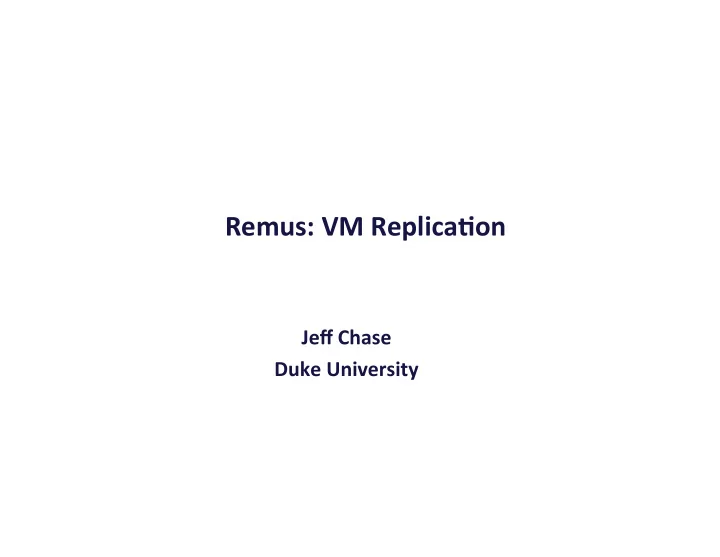

Remus: ¡VM ¡Replica/on ¡ Jeff ¡Chase ¡ Duke ¡University ¡
Recall: virtual machines (VMs) • Each guest VM runs a complete OS instance over an isolated “sliver” of host physical memory. • Hypervisors support migration and suspend/resume . – Both operations require an atomic snapshot (checkpoint) of VM memory state and register contexts. – Capture modified pages and write them to snapshot. guest guest kernel host hypervisor (VMM)
Capturing modified pages • How to do it? • Recall the Address Translation Uses slides earlier. • <Discuss.>
Remus checkpoints • Snapshot the VM, but don’t suspend it. – Snapshot periodically as it executes. – Snapshot concurrently: keep running while snap is in progress. • Migrate the VM, but don’t start the remote copy. – Just load the snapshot on the remote host. – Transmit “live” incremental checkpoints over the network. – Update the remote snapshot/copy/instance in place. – Remote host is a warm standby or backup replica . • All checkpoints are atomic : they capture a point in time.
Remus Checkpoints n Remus divides time into epochs (~25ms) n Performs a checkpoint at the end of each epoch 1. Suspend primary VM 2. Copy all state changes to a buffer in Domain 0 3. Resume primary VM 4. Send asynchronous message to backup containing state changes 5. Backup VM applies state changes Periodic Checkpoints Primary Backup Domain 0 Domain 0 (Changes to VM State) VM VM Xen VMM Xen VMM Primary Backup Server Server 5 [Ashraf Aboulnaga RemusDB]
Transparent HA for DBMS VM VM Changes to VM State DBMS DBMS DB DB Primary Backup Primary Server Server Server n RemusDB: efficient and transparent active/standby high availability for DBMS implemented in the virtualization layer n Propagates all changes in VM state from primary to backup n High availability with no code changes to the DBMS n Completely transparent failover from primary to backup n Failover to a warmed up backup server 6 [Ashraf Aboulnaga RemusDB]
Remus
Remus Checkpoints n After a failure, the backup resumes execution from the latest checkpoint n Any work done by the primary during epoch C will be lost (unsafe) n Remus provides a consistent view of execution to clients n Any network packets sent during an epoch are buffered until the next checkpoint n Guarantees that a client will see results only if they are based on safe execution n Same principle is also applied to disk writes 8 [Ashraf Aboulnaga RemusDB]
Outbound packet buffering
Disk (FS) updates
Remus implementation
Tardigrade (NSDI-15)
Remus checkpoint latency
Remus overhead
Tardigrade
Tardigrade
Recommend
More recommend